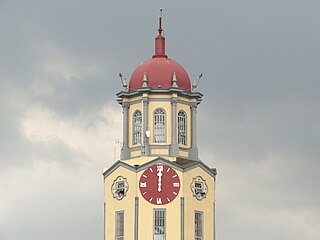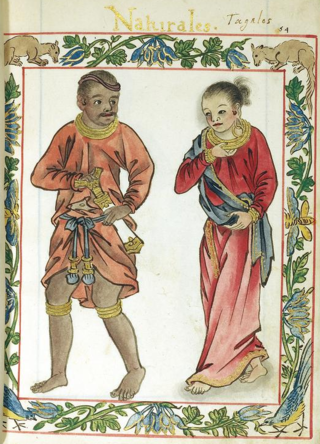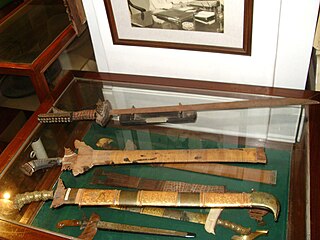Related Research Articles

Miguel López de Legazpi, also known as El Adelantado and El Viejo, was a Spanish conquistador who financed and led an expedition to conquer the Philippine islands in the mid-16th century. He was joined by Guido de Lavezares, relative Martin de Goiti, friar Andrés de Urdaneta, and his grandsons Juan and Felipe de Salcedo, in the expedition. Legazpi established the first Spanish settlement in the East Indies after his expedition crossed the Pacific Ocean, arriving in Cebu in 1565. He became the first Governor-General of the Spanish East Indies, which was administered from New Spain for the Spanish crown. It also encompassed other Pacific islands, namely Guam, the Mariana Islands, Palau, and the Carolinas. After obtaining peace with various indigenous tribes and kingdoms, he made Cebu City the capital of the Spanish East Indies in 1565 and later transferred to Manila in 1571. The capital city of the province of Albay bears his name.

Juan de Salcedo was a Spanish conquistador. He was the grandson of Spanish general Miguel López de Legazpi. Salcedo was one of the soldiers who accompanied the Spanish conquest to the Philippines in 1565. He joined the Spanish military in 1564 at age 15, on their voyage of exploration to the East Indies and the Pacific, in search of rich resources such as gold and spice, and to find a passage to the islands were the previous Spanish expeditions led by Ferdinand Magellan had landed in 1521, and Ruy López de Villalobos in 1543.

Sulayman, sometimes referred to as Sulayman III, was a Crown Prince of the Kingdom of Luzon in the 16th century and was a nephew of King Ache of Luzon. He was the commander of Luzonian forces in the battle of Manila of 1570 against Spanish forces.
Lakandula was the title of the last lakan or paramount ruler of pre-colonial Tondo when the Spaniards first conquered the lands of the Pasig River delta in the Philippines in the 1570s.
Martín de Goiti was a Spanish conquistador and one of the soldiers who accompanied the Spanish voyage of exploration to the East Indies and the Pacific in 1565, in search of rich resources such as gold, spice and settlements. They were seeking to find a route to the islands were the previous Spanish expeditions led by Ferdinand Magellan had landed in 1521, and Ruy López de Villalobos in 1543.

In early Philippine history, the Tagalog and Kapampangan settlement at Tondo, sometimes referred to as the Kingdom of Tondo, was a major trade hub located on the northern part of the Pasig River delta on Luzon island. Together with Maynila, the polity (bayan) that was also situated on the southern part of the Pasig River delta, Tondo had established a shared monopoly on the trade of Chinese goods throughout the rest of the Philippine archipelago, making it an established force in trade throughout Southeast Asia and East Asia.

The Battle of Bangkusay, on June 3, 1571, was a naval engagement that marked the last resistance by locals to the Spanish Empire's occupation and colonization of the Pasig River delta, which had been the site of the indigenous polities of Rajahnate of Maynila and Tondo.

Akí, also known as Rája Matandâ, was King of Luzon who ruled from the kingdom's capital Manila, now the capital of the Republic of the Philippines.

Tarik Sulayman, also spelled Tarik Soliman, is the most popular of several names attributed by Kapampangan historians to the individual that led the forces of Macabebe against the Spanish forces of Miguel López de Legazpi during the Battle of Bangkusay Channel on June 3, 1571. Aside from "Tarik Sulayman", this individual has also been associated with the names Bambalito or Bankau by some historians, while others simply consider him "nameless."

In Philippine history, the Tagalog bayan of Maynila was one of the most cosmopolitan of the early historic settlements on the Philippine archipelago. Fortified with a wooden palisade which was appropriate for the predominant battle tactics of its time, it lay on the southern part of the Pasig River delta, where the district of Intramuros in Manila currently stands, and across the river from the separately-led Tondo polity.

The earliest recorded history of Manila, the capital of the Philippines, dates back to the year 900 AD, as recorded in the Laguna Copperplate Inscription. By the thirteenth century, the city consisted of a fortified settlement and trading quarter near the mouth of the Pasig River, the river that bisects the city into the north and south.
Panday Pira was a Filipino kapampángan blacksmith His name literally translates as "Blacksmith Pira", panday being the Tagalog word for "blacksmith".

The 1570 Battle of Manila was fought in Manila between Luzonians, led by Prince Sulayman, and Spaniards, led by field marshal Martin de Goiti, on 24 May 1570. Goiti's forces eventually besieged the fort of Manila, destroyed Manila, and won the battle, with the site of the fort falling to the Kingdom of the Spains and the Indies. The Spaniards then founded a Spanish city of Manila making it the capital of the Spanish East Indies.
Datu Magat Salamat was a Filipino historical figure best known for co-organizing the Tondo Conspiracy of 1587. He was one of at least four sons of Lakandula, and thus held the title of Datu under his cousin and co-conspirator Agustin de Legazpi, who had been proclaimed paramount ruler of the indianized kingdom of Tondo after the death of Lakandula, although the position soon became little more than a courtesy title.
Pengiran Seri Laila, or Panguilan Salalila in Spanish records, was a pengiran or married member of the Bruneian royal family and was the uncle of Sultan Sayf ul-Rijal of Brunei. By the 1570s, he had much involvement with the Kingdom of Luzon and Brunei's Castilian War. His name is now often found as the surname "Salalila" from Tagalog and Kapampangan regions of Luzon in the Philippines.

Dayang Kalangitan is a legendary figure in early Philippine history who was said to be Dayang of the pre-Hispanic Indianized polity of Pasig. She was co-regent of Pasig with her husband, Rajah Lontok, and later sole ruler of their realms. She is one of the very few known female leaders in precolonial Philippine history.
The following is a timeline of the history of the city and metropolitan area of Manila, the capital city of the Philippines.

Warfare in pre-colonial Philippines refers to the military history of the Philippines prior to Spanish colonization.
Agustin de Legazpi is a prominent historical figure in the Philippines best known as the leader of the Tondo Conspiracy of 1587–1588, the last native ruler of Tondo, and the last individual to hold the title of paramount ruler in any of the Indianized indigenous Tagalog polities of the Pasig River delta, although it had been reduced to little more than a courtesy title by the time of Agustin de Legazpi's execution. He was a great grandson of the Bruneian Sultan and distant descendant of Caliph Hasan ibn Ali and was a convert from Islam to Christianity, his Bruneian name was Rajah Muhammad Zahir al-Din.
References
- 1 2 3 4 5 6 7 8 "The romance of Juan de Salcedo and Lakandola's niece, Dayang-Dayang Candarapa" published in the Kahimyang Project, Citing: Romance and adventure in old Manila, by Walter Robb, from manuscripts of Percy A. Hill, Philippine Education Company, Manila, 1935
- 1 2 Ordoñez, Minyong (2012-08-19). "Love and power among the 'conquistadors'". Philippine Daily Inquirer. Retrieved 2017-09-28.
- ↑ Charles A. Truxillo (2012), Jain Publishing Company, "Crusaders in the Far East: The Moro Wars in the Philippines in the Context of the Ibero-Islamic World War".
- ↑ Don Felipe Cepeda by Nick Joaquin
- ↑ "The Burlington Magazine". JSTOR. 110 (788): 629–631. 1968. ISSN 0007-6287. JSTOR 875819.
- ↑ Kenoyer, Jonathan M.; Heuston, Kimberley Burton (2005). The Ancient South Asian World. Oxford University Press. p. 93. ISBN 978-0-19-522243-2.
- ↑ Groner, Paul; Stone, Jacqueline I. (2014), "Editors' Introduction: The "Lotus Sutra" in Japan", Japanese Journal of Religious Studies, 41 (1): 1–23, archived from the original on June 14, 2014
- ↑ Besa, Emmanuel (22 September 2017). Tales of Intramuros. ISBN 9781365753626 . Retrieved 19 January 2019.